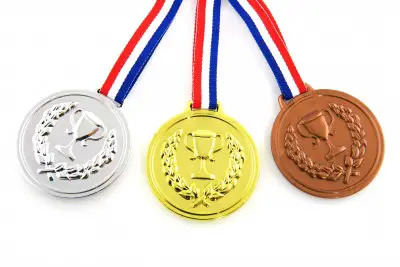Each time the Olympics come around again, there’s inevitably talk about performance-enhancing drugs and other technologies. This year, topics include gene doping and the controversy over permitting Oscar Pistorius, the South African track athlete who runs with carbon fiber prostheses, to compete in the London Games.
 To better understand these issues, we turned to local expert Thomas Murray, Ph.D., who serves as chair of the Ethical Issues Review Panel for the World Anti-Doping Agency. Read on to inform yourself about these ethical sports issues—so you have a good answer when your kids start asking about them and so you know what to expect if your kids reach a high level in sports.
To better understand these issues, we turned to local expert Thomas Murray, Ph.D., who serves as chair of the Ethical Issues Review Panel for the World Anti-Doping Agency. Read on to inform yourself about these ethical sports issues—so you have a good answer when your kids start asking about them and so you know what to expect if your kids reach a high level in sports.
What is “gene doping?”
The phrase “gene-doping” is a combination of gene therapy—an effort to insert genes or otherwise modify the genome of particular cells in order to cure a disease—and doping, which is doing the same thing, but for the purpose of enhancing performance.
How does gene doping work?
There are a number of different strategies. Many of them rely on trying to insert a particular gene into the DNA of your cells; these are the most common.
One of the earliest forms of gene therapy was created for young boys with a specific immune deficiency disease. Scientists were able to insert a healthy form of the gene—a form that made the correct proteins—into the cells of the boys. As a result, the boys began to make enough of the gene product. They didn’t make a normal level, like the level you or I would make, but it was enough to enable them to live a more active life. Before then, they lived in a “bubble boy” existence, where they had to be protected from all infections. That is the good news. The bad news is that the same procedure of gene therapy also caused leukemia in several of these boys.
Genes are just DNA sequences that sit there. In fact, in most cells the great majority of genes are turned off once the cell has reached its mature status. If I were to estimate, I would say as many as 90 percent of the genes in any given cell in your body is inactive. Different combinations of genes allow liver cells, neurons, heart cells, etc. to perform their duties. There are ways to try to turn genes on or turn them off. Some gene-doping strategies are probably attempting to do that—a modification of gene expression.
What other genetic means are there for enhancing sports performance?
There is a second, barely related, [method] used known as genetic screening and testing. That effort is based on the observation that pretty much all of our genes exist in multiple forms, called alleles. There is a gene called the action 3 gene, ACTm3, and observations have been made in several studies that endurance runners and people who rely on explosive power—sprinters and some other power-related sports—are more likely to have different alleles than the ACTm3 gene. Based on some of those rather small findings, some companies have started offering genetic tests. This is absurd for two reasons. Number one, although the companies say they will not give the test to children, people are going to be interested in gene testing primarily in finding out which form of the gene their children have so that they can steer their children into a certain direction like long-distance running or cycling versus sprinting or weight-lifting. Secondly, the way they get the sample is through a kit that they send you containing a cotton swab, which you stick inside a test tube and send back to the company. The company has no idea where you got that sample from. You can tell them it is from you, but you could have taken it from your children.
The type of allele accounts for a very tiny percentage of the variants in who is going to be better at one thing or another. For $129 for the test, you would be far better off investing in a really good stopwatch and seeing how fast your kid can run. A stopwatch is going to be a more accurate predictor, plus, you can use it more than once.
What are the risks of gene doping?
The main risk is that the way our genomes function is incredibly complex. Think of the genome in each of your individual cells as a very complex ecosystem, where the genes are talking to one another. If one turns on it may turn the other off. The genes turn each other up and down and do this in very complex feedback loops. Even if you get the gene in the cell, it can be very difficult to predict the actual consequences of that gene expressing itself. There will be many unanticipated consequences and in all likelihood more of them are going to be bad than good. Genes can also be difficult to control.
What are the anti-doping efforts like at the Olympics?
My understanding at this time is that the techniques being used to detect tinkering with gene doping are not ready to be fully deployed, although, there are a number of very promising ones. There is some impressive work going on. Athletes need to remember that the samples that they provide at the games will be retained for a number of years and they can be disqualified many years from now. That has happened to athletes; they’ve had medals stripped from them and been disqualified years after their event—this is part of the doping protocol. Though athletes may think they can get away with it now, they may well be caught years from now.
In my heart of hearts, I doubt that there is any gene doping going on that is going to have an impact on results because it is extremely unlikely that anyone knows how to do it yet. It’s not that people wouldn’t try it and that there aren’t outlaws out there peddling and propelling what they claim to be gene doping, but it is likely not to make any difference.
Will gene doping grow to be a bigger problem in the future?
As technology matures, there will be more avenues, and there will be more people who will have the technical ability to perform gene doping. As long as the efforts being made right now continue, there will be gene doping in the future. The issue is how successful it will be. This depends on two factors. One is how successful the anti-doping movement will be and what the varying technical efforts will show. The second factor is the word of mouth that will spread underground in the athlete community as in whether gene doping works or not. Unfortunately, many athletes are gullible and will sort of latch onto anything that some guru tells them works. What I hope doesn’t happen is that a couple of horrendous examples arise out of horrendous damage done to individuals because they tried gene doping. That would be deeply sad.
Thomas Murray, Ph.D., a bioethicist and leading expert on ethical questions in sport, serves as chair of the Ethical Issues Review Panel for the World Anti-Doping Agency as well as senior research scholar and president emeritus of The Hastings Center, a bioethics research institute based in Garrison, NY. Murray is currently writing a book on fairness in sport with the working title “Why We Play.”















